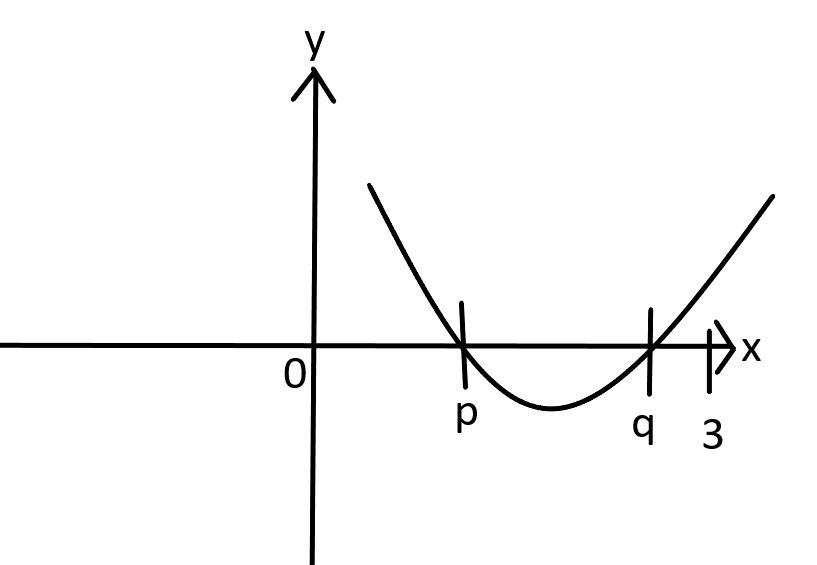
If the roots of the equation ${x^2} - 2ax + {a^2} + a - 3 = 0$ are real and less than 3, then
A. $a < 2$
B. $2 \leqslant a \leqslant 3$
C. $3 < a \leqslant 4$
D. $a > 4$
Answer
219.6k+ views
Hint: Check the concavity of the given quadratic equation and using this information check whether $f(3)$ is positive or negative. Also use the fact that the discriminant must be greater than or equal to 0 as real roots exist. With the two inequalities, find the range of a.
Formula used: Discriminant of the standard quadratic equation $a{x^2} + bx + c = 0$ is ${b^2} - 4ac$
Complete step-by-step solution:
Let $f(x) = {x^2} - 2ax + {a^2} + a - 3$
The coefficient of ${x^2}$ in the equation ${x^2} - 2ax + {a^2} + a - 3 = 0$ is greater than 0. Therefore, it is a concave upwards graph. Since it is a concave upwards graph, $f(x)$ will be negative only when $x \in \left[ {p,q} \right]$ where $p,q$ are the roots.

Therefore, $f(3)$ is positive. We also know that real roots exist. Therefore, the discriminant of the quadratic equation, ${x^2} - 2ax + {a^2} + a - 3 = 0$ must also be greater than or equal to 0.
Since $f(3) > 0$,
${3^2} - 2a(3) + {a^2} + a - 3 > 0$
$9 - 6a + {a^2} + a - 3 > 0$
${a^2} - 5a + 6 > 0$
Solving further we get,
${a^2} - 2a - 3a + 6 > 0$
$a\left( {a - 2} \right) - 3\left( {a - 2} \right) > 0$
$\left( {a - 2} \right)\left( {a - 3} \right) > 0$
$a \in \left( { - \infty ,2} \right) \cup \left( {3,\infty } \right)$
Since discriminant, $D \geqslant 0$,
${\left( { - 2a} \right)^2} - 4\left( 1 \right)\left( {{a^2} + a - 3} \right) \geqslant 0$
$4{a^2} - 4{a^2} - 4a + 12 \geqslant 0$
Simplifying the above inequality,
$4a \leqslant 12$
$a \leqslant 3$
$a \in ( - \infty ,3]$
Taking the intersection of $\left( { - \infty ,2} \right) \cup \left( {3,\infty } \right)$ and $( - \infty ,3]$, we get $a \in \left( { - \infty ,2} \right)$.
Therefore, the correct answer is option A. $a < 2$.
Note: Given a quadratic polynomial $a{x^2} + bx + c$, if $a > 0$ then the graph of the quadratic polynomial will be a concave upwards graph and if $a < 0$ then the graph of the quadratic polynomial will be a concave downwards graph.
Formula used: Discriminant of the standard quadratic equation $a{x^2} + bx + c = 0$ is ${b^2} - 4ac$
Complete step-by-step solution:
Let $f(x) = {x^2} - 2ax + {a^2} + a - 3$
The coefficient of ${x^2}$ in the equation ${x^2} - 2ax + {a^2} + a - 3 = 0$ is greater than 0. Therefore, it is a concave upwards graph. Since it is a concave upwards graph, $f(x)$ will be negative only when $x \in \left[ {p,q} \right]$ where $p,q$ are the roots.

Therefore, $f(3)$ is positive. We also know that real roots exist. Therefore, the discriminant of the quadratic equation, ${x^2} - 2ax + {a^2} + a - 3 = 0$ must also be greater than or equal to 0.
Since $f(3) > 0$,
${3^2} - 2a(3) + {a^2} + a - 3 > 0$
$9 - 6a + {a^2} + a - 3 > 0$
${a^2} - 5a + 6 > 0$
Solving further we get,
${a^2} - 2a - 3a + 6 > 0$
$a\left( {a - 2} \right) - 3\left( {a - 2} \right) > 0$
$\left( {a - 2} \right)\left( {a - 3} \right) > 0$
$a \in \left( { - \infty ,2} \right) \cup \left( {3,\infty } \right)$
Since discriminant, $D \geqslant 0$,
${\left( { - 2a} \right)^2} - 4\left( 1 \right)\left( {{a^2} + a - 3} \right) \geqslant 0$
$4{a^2} - 4{a^2} - 4a + 12 \geqslant 0$
Simplifying the above inequality,
$4a \leqslant 12$
$a \leqslant 3$
$a \in ( - \infty ,3]$
Taking the intersection of $\left( { - \infty ,2} \right) \cup \left( {3,\infty } \right)$ and $( - \infty ,3]$, we get $a \in \left( { - \infty ,2} \right)$.
Therefore, the correct answer is option A. $a < 2$.
Note: Given a quadratic polynomial $a{x^2} + bx + c$, if $a > 0$ then the graph of the quadratic polynomial will be a concave upwards graph and if $a < 0$ then the graph of the quadratic polynomial will be a concave downwards graph.
Recently Updated Pages
The angle of depression of the top and the bottom of class 10 maths JEE_Main

Find the value of sin 50 circ sin 70 circ + sin 10 class 10 maths JEE_Main

The amount of work in a leather factory is increased class 10 maths JEE_Main

The side BC of a triangle ABC is bisected at D O is class 10 maths JEE_Main

The circumference of the base of a 24 m high conical class 10 maths JEE_Main

Mutually Exclusive vs Independent Events: Key Differences Explained

Trending doubts
JEE Main 2026: Application Form Open, Exam Dates, Syllabus, Eligibility & Question Papers

JEE Main Syllabus 2026: Download Detailed Subject-wise PDF

JEE Main Previous Year Question Papers (2014–2025) with Answer Keys and Solutions

Exothermic Reactions: Real-Life Examples, Equations, and Uses

JEE Main Marks vs Percentile vs Rank 2026: Calculate Percentile and Rank Using Marks

Understanding Newton’s Laws of Motion

Other Pages
NCERT Solutions For Class 10 Maths Chapter 12 Surface Area And Volume

NCERT Solutions for Class 10 Maths Chapter Chapter 13 Statistics

NCERT Solutions for Class 10 Maths Chapter 11 Areas Related to Circles 2025-26

Pregnancy Week and Due Date Calculator: Find How Far Along You Are

Complete List of Class 10 Maths Formulas (Chapterwise)

NCERT Solutions for Class 10 Maths Chapter 15 Probability




